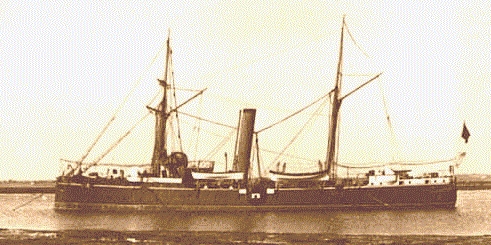


The ISLA DE CUBA was completed in 1887 and joined the fleet of metropolis, based at Cadiz, Spain. During 1893 and 1894, the vessel took part in the Moroccan War, and bombarded the reefs between Melilla and Chafarinos.
With the beginning of the Philippine Insurrection against Spain, The ISLA DE CUBA, along with her sister ship, the ISLA DE LUZON, was sent to the Philippines to join the squadron of Admiral Montojo. At the beginning of the Spanish American War, she was one of the most powerful and modern vessel in the squadron.
During the Battle of Manila Bay/Cavite the ISLA DE CUBA served on the right flank of the Spanish squadron. At first the ships of the American Asiatic Squadron concentrated their fire on the larger REINA CRISTINA and CASTILLA. As a result, the ISLA DE CUBA suffered little damage. After Admiral Montojo's flagship REINA CRISTINA was disabled, Montojo transferred his flag to the ISLA DE CUBA. During the remainder of the battle, she suffered five hits of small caliber. Two of her crewmen were wounded. Immediately after the battle, a party from the PETREL was sent aboard the ISLA DE CUBA to set her afire.
After the cruiser was salvaged, she was towed to Singapore for repair. On April 4, 1900, the repair work on her was completed and she was commissioned as a vessel in the U.S. Navy under the command of Lt. J. N. Jordan. She served in the Philippines during the Philippine Insurrection against the United States as a supply ship and a patrol boat. From November 17 to December 8, her crew landed and held the town of Ormoc, Leyte while the army garrison was away on a mission against the Insurgents. Later, in 1901, she made a survey of the Ormoc anchorage as well as Parasan Harbor. In March and April, she "rendered distiguished service" in cutting off supplies to the Insurgents in Samar and in aiding in the capture of Lukban, the Insurgent leader in the area.
ISLA DE CUBA returned to the United States on March 4, 1904 and was decommissioned at Portsmouth, New Hampshire on June 9. After repairs, in 1907 she was loaned to the Maryland Naval Militia as a training vessel.
She was sold to Venezuela on February 2, 1912 and was renamed MARISCAL SUCRE. She was in use until scrapped in 1940.
ADVANTAGES/DISADVANTAGES:
The vessel was a small protected cruiser, or, more properly a gunboat.
Her ratio of length to beam was small, and as a result, she had poor seagoing
capabilities. She had a tendency to bury her bow into the waves.
| Classification: | Protected Cruiser, 2nd Class | |
|---|---|---|
| Laid down: | February 25, 1886 | |
| Launched: | December 11, 1886 | |
| Completed: | September 22, 1887 | |
| Rig: | Two masts, schooner rig | |
| Armament: | Four 120mm/35 cal. (4") Hontoria Breechloading guns | |
| Four 57mm/43 cal. (6 pounder) Nordenfeldt guns | ||
|
Three 37 mm/20 cal. revolving guns
|
||
| Three 356 mm (14") torpedo tubes | ||
| Contractor: | Armstrong (Elswick, UK) | |
| Length: | 56.11 meters | |
| Beam: | 8.87 meters | |
| Draft: | 3.84 meters | |
| Displacement: | 1030 tons | |
| Complement: | 164 Officers and Enlisted Men under the command of Capt. J. Sidrach | |
| Engine type: | Horizontal triple-expansion engines, 2600 hp. Two shafts. | |
| Boiler type: | Two boilers | |
| Speed: | 15.9 knots (during speed trials) | |
| Bunker Capacity: |
160 tons
|
|
| Coal Endurance: |
2,000 miles
|
|
| Armor: | 25mm to 64 mm, deck; 51 mm casemate | |
| Cost: |
2.4 million pesetas
|
Dictionary of American Naval Fighting Ships, Vol. III (Washington DC: U.S. Government Printing Office, 1977) 466.
Wilson, H. W., Downfall of Spain (London: 1900).

